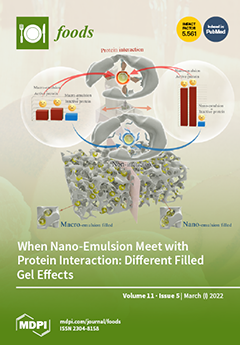Seafood is an excellent source of nutrients, essential for a healthy diet, ranging from proteins and fatty acids to vitamins and minerals. Seafood products are highly perishable foods due to their nutritional characteristics and composition. The application of nontoxic, natural, and edible preservatives
[...] Read more.
Seafood is an excellent source of nutrients, essential for a healthy diet, ranging from proteins and fatty acids to vitamins and minerals. Seafood products are highly perishable foods due to their nutritional characteristics and composition. The application of nontoxic, natural, and edible preservatives to extend the shelf-life and inhibit bacterial proliferation of several foods has been a hot topic. Consequently, this work aimed to perform the microbiological characterization of squid and shrimp skewers during their shelf-life (five days) and evaluate the susceptibility of randomly isolated microorganisms to several natural edible compounds so that their application for the preservation and shelf-life extension of the product might be analyzed in the future. The product had considerably high total microorganisms loads of about 5 log CFU/g at day zero and 9 log CFU/g at day five. In addition, high bacterial counts of
Pseudomonas spp., Enterobacterales, and lactic acid bacteria (LAB) were found, especially on the last day of storage, being
Pseudomonas the dominant genus. However, no
Escherichia coli or
Listeria monocytogenes were detected on the analyzed samples. One hundred bacterial isolates were randomly selected and identified through 16s rRNA sequencing, resulting in the detection of several Enterobacterales,
Pseudomonas spp., and LAB. The antibacterial activity of carvacrol, olive leaf extract, limonene, Citrox
®, different chitosans, and ethanolic propolis extracts was evaluated by the agar diffusion method, and the minimum inhibitory concentration was determined only for Citrox
® since only this solution could inhibit all the identified isolates. At concentrations higher than or equal to 1.69% (
v/v), Citrox
® demonstrated bacteriostatic and bactericidal activity to 97% and 3% of the isolates, respectively. To our knowledge, there are no available data about the effectiveness of this commercial product on seafood isolates. Although preliminary, this study showed evidence that Citrox
® has the potential to be used as a natural preservative in these seafood products, improving food safety and quality while reducing waste. However, further studies are required, such as developing a Citrox
®-based coating and its application on this matrix to validate its antimicrobial effect.
Full article






